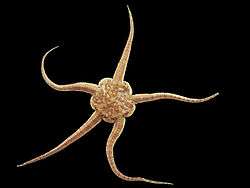Ophiuridae
Ophiuridae are a large family of brittle stars of the suborder Ophiurina.
| Ophiuridae | |
|---|---|
 | |
| Ophiura ophiura | |
| Scientific classification | |
| Kingdom: | |
| Phylum: | |
| Class: | |
| Order: | |
| Suborder: | |
| Infraorder: | Chilophiurina |
| Family: | Ophiuridae Lyman, 1865 |
| Genera | |
|
See text. | |
Description
The arms are simple and unbranched, projecting from and well-fused to the edge of the disc. These arms move horizontally. The arm spines short and movable. They lie flat against the arms when stimulated, but held erect when the brittle star is at rest. Disc and arms are covered in naked, distinct scales. The scales are situated at both sides of the disc.
The jaw is surrounded by a continuous series of mouth papillae. The base of the arm contains a single arm comb or an inner and outer arm comb.
Systematics and phylogeny
The fossils of Ophiuridae date back to Carboniferous (Aganaster†).[1] The family includes the following living genera:[2]
- Anthophiura
- Astrophiura
- Dictenophiura
- Euvondrea
- Gymnophiura
- Haplophiura
- Homophiura
- Ophiambix
- Ophioceramis
- Ophiochalcis
- Ophiochorus
- Ophiochrysis
- Ophiocrates
- Ophiocrossota
- Ophioctenella
- Ophiocypris
- Ophioelegans
- Ophiogona
- Ophiolipus
- Ophiomisidium
- Ophionotus
- Ophiopenia
- Ophiophyllum
- Ophiopleura
- Ophiopyren
- Ophiopyrgus
- Ophiosphalma
- Ophiosteira
- Ophioteichus
- Ophiotjalfa
- Ophiotylos
- Ophiotypa
- Ophiozona
- Ophiura
- Ophiuraster
- Ophiurinae
- Ophiuroglypha
- Sinophiura
- Spinophiura
- Stegophiura
- Theodoria
- Uriopha
(This list includes the genera sometimes placed in the family Ophioleucidae, here included in Ophiuridae as the subfamily Ophioleucinae[3]).
References
- Hansson, H.G. (2001). Echinodermata, in: Costello, M.J. et al. (Ed.) (2001). European register of marine species: a check-list of the marine species in Europe and a bibliography of guides to their identification. Collection Patrimoines Naturels, 50: pp. 336–351
- P.J. Hayward and J.S. E-Ryland (ed.), Handbook of the Marine Fauna of North-West Europe, Oxford University Press, Oxford, 1996, ISBN 0-19-854055-8